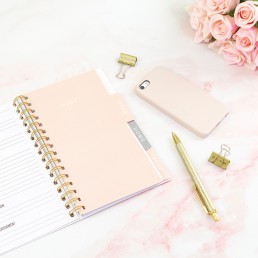Why I Chose ELLE Education

My name is Gabriela Ionescu, I am 31 years old, originally from Romania but currently live in Luxembourg, I attended the Image Consultant and Personal Shopper short course and I wanted to share with you today why I chose ELLE Education.
First of all I have been a big fan of the ELLE magazine since I was a teen and when I found out that they also have fashion trainings and formation available, I was really thrilled. I knew this is my perfect chance to absorb and extract all the information in regards with this subject.
I believe the program that ELLE Education developed for us it s absolutely challenging, offers us a different view of the industry, enriching us with knowledge and fresh perspectives.
A while ago there was also an Online webinar on World Ocean's Day before I enrolled myself in the program which got my attention, the main message was: full circularity Is the way to sustainability. I found it very intriguing and interesting, as it was saying that to become circular, the fashion industry needs to make fundamental changes in three key areas: product design, infrastructure and business models. I learned a lot from that and it was the perfect trigger to start another path in my life together with ELLE Education.
So, if you are trying to understand how to define your own fashion sense, be updated on the fashion world, aesthetics, etc, continue reading ELLE and take advantage of all the information, they are good tips on how to start figuring your own journey.
Gabriela Ilonescu (Image Consultant and Personal Shopper)
What is in a Fashion Stylist’s Case?
Style, creativity and hard work; three qualities behind the role of the fashion stylist, but what does a fashion stylist actually do? It is quite obvious that their main role is to create styles, but what companies need a stylist for depends on the project! A celebrity stylist has different priorities than a brand stylist, or a personal stylist. What remains constant is the fact that stylists work with clothes, make-up and hairdressing to achieve their final vision, and that they have thorough knowledge of trends, morphology, fabrics, patterns, and other disciplines such as history and film amongst others. They need to always be ready to make adjustments, fix looks on mannequins, etc. Today we are going to point out what should always be included in a stylist’s case.
1.Needle and thread
Essential to sew buttons, lifting the bottom of dresses, and small adjustments.
2. Double-sided tape
Very important if you cannot sew and need to create a hemline, and to maintain clothes in its place.
3. Iron
Either a traditional one or a vertical steam one!
4. Lint roller
An absolute must!
5. Safety pins
These are very needed to fasten clothes to a mannequin or something that must not be noticed!
6. Small scissors
Never know when you need to cut a label or a thread!
7. Stain remover
Accidents do happen, and sometimes water cannot be used and is not enough!
Want to learn all the secrets of industry professionals? Join our Visual Merchandising and Fashion Stylist diploma course accredited by Complutense University of Madrid. Get started on turning your gift of style into a profession!
2020 Global Retail Trends
2020 has taken the retail industry by surprise, not unlike all other industries, the uncertainty of this year has made some retailers blossom and others struggle to survive. Based on this study by KPMG, today we discuss the trends in retail for this year.
There are four main trends in the retail industry this year, however, they are not new, they have just been accelerated by the global changes in the world.
1-Business Model Evolution
The dilemma of the brick-and-mortar vs. online stores has been brought up to the center stage in view of global confinement. Growth can no longer be driven by physical stores, they still have a place in the industry, but they cannot be the driving force behind the retail business.
2- Purpose Has Become More Important Than Ever
Based on consumer demand the private sector has moved across all industries from the profit-over-people dogma and moved towards people-over-profit. The global pandemic only made that trend stronger, more and more consumers buy or boycott based on the values of a brand.
3-Cutting Costs is No Longer Such an Easy Task
Traditional ways to cut costs are no longer enough to maintain businesses afloat or revamp them, aggressive immediate cost-cutting strategies have shown retailers that they need to go much further to stimulate long term growth. This translates into more investment in the enhancement of existing assets that already provide value.
4-The Power of the Consumer Has Increased Even More
Consumer demand was already identified as a driving force behind innovation, and thus taken very seriously, today we see this trend getting stronger. Customers want availability above all, especially in these uncertain times, and that will change the operations of several retailers. Retailers that know their customer well and know which channels to be on have a clear advantage.
The Role of the Event Producer During an Event
Event Producers are the key piece in running a successful event. They put everything together and are the go-to person in event management, they are the engine in making sure everything runs smoothly. Every action they take trickles down to the rest of the team, so what exactly do they have to do during the event?
Remain Calm
Having a nervous and commanding attitude will affect the working environment and how each team member approaches their work, you have to prioritize staying calm. No one solves issues in an alarmed state of mind.
Stay Flexible
With a solid pre-plan for the event you are ready to tackle all you could foresee, but events have an unpredictability factor, and you have to be ready for things to not go always according to plan, finding solutions and having a problem-solving attitude is what will make you a great event producer.
Keep Safe
Ensuring the working spaces are safe, that the crew makes a good clean up to avoid accidents, and that the safety equipment is in place also forms part of a great event.
Stay Organized
Site builds can get messy and chaotic, things can get lost, keep a clipboard with you with all important information and documents.
Be Available!
Make sure you are always reachable. Extra chargers are encouraged.
Never Leave Site
As an Event Producer you should always be on-site, unless it is absolutely imperative.
8 Characteristics of a Consumer-Centric Firm
Some groundbreaking innovation comes from just listening to the demands of consumers. The business world has finally caught on, and this is now what we consider part of the best practices. Today we discuss 8 characteristics of a consumer-centric firm.
1-Values are clearly defined!
These companies are value-based and have a very active leadership. They are people-oriented and have set up processes that reflect that.
2- Obsession with offering the best service
The corporate culture is simple, and the main pillar is: the consumer is always first. Everything is about offering the absolute best service, the best quality products, and creating a relationship with their customers. This is a goal common to everyone across departments and positions.
3-Quick responses to change
Being dynamic is part of their DNA, continuous improvement is something they are good at. They are not afraid to change their processes or products to fit the needs of their clients.
4- Risk-takers!
These companies are made up of explorers and pathfinders. They are willing to experiment despite uncertainty. They know who they are, so their changes and experiments are always “on-brand”.
5-Realistic to the core
They embrace the engagement with the consumer and take their feedback very seriously, they listen to them and know where they stand with their customer. By nature, they are empathetic.
6- Information rich
They are constantly listening, which means they are constantly changing, testing, and implementing in order to fit their customer’s needs.
7- Strong leaders
These companies have strong, competent leaders that exemplify the behavior they want to see in their company. They are active designers of the next changes.
8-Global goals
They look to be the best in the world in their market.
Do you have an entrepreneurial mind, and want to gain the skills to create an exceptional lifestyle brand? Time to check out our How to Create a Brand short course! Learn from experts and the latest research. Take the first step towards your goals.
My Experience at ELLE Education
 My name is Ingrid J. Dua Lucu, I am British, have Ghanaian roots, grew up in Germany and live in Slovenia now. I attended the "How to Create a Brand" short course because I am embarking on a new entrepreneurial venture in the field of fashion. I loved the course from the first second, and am still amazed about how much I have learned. All the reading material was on a very high level, the video lectures really support the reading and made everything more comprehensible and interesting. To me, it was very important to acquire the necessary knowledge in the field I intend to work in. I feel much more equipped and more secure, which will surely be reflected in my relationships with my business partners. I very much appreciated having a tutor, who was always available and helped with
My name is Ingrid J. Dua Lucu, I am British, have Ghanaian roots, grew up in Germany and live in Slovenia now. I attended the "How to Create a Brand" short course because I am embarking on a new entrepreneurial venture in the field of fashion. I loved the course from the first second, and am still amazed about how much I have learned. All the reading material was on a very high level, the video lectures really support the reading and made everything more comprehensible and interesting. To me, it was very important to acquire the necessary knowledge in the field I intend to work in. I feel much more equipped and more secure, which will surely be reflected in my relationships with my business partners. I very much appreciated having a tutor, who was always available and helped with
any questions I had. The ELLE Education program is perfectly organised. It is a big plus that it allowed me to organise my own time schedule and take the tests in my own time. I gained so much knowledge that I look forward to implementing all in my new business venture.
Thank you ELLE&mindway.
Ingrid J. Dua Lucu(How to Create a Brand)
Tips to Build a Product Design Portfolio
You decided to use your creativity to follow the exciting career path of product design, you have completed ELLE Education's Product Design short course, now it is time to show the world (possible clients or recruiters) what you can do. Here are some tips to build the best one:
1- Take your audience into account
Who are you showing this to? Why is it relevant to them? What do they want to see?
2-Pick your best work
Sounds obvious, but it is a build up from the first step. You have to ask yourself what you want to show about yourself to your audience, and pick your best work with an objective and purpose in mind, whether to build your reputation, or get a job.
3-Choose the correct format!
The easier it is to access, the more accessible it is for the people who wish to see it.
4-Show off your creativity
You are a creative being that needs to express their personality through other channels, use this opportunity to showcase how far your creativity can go.
5-Talk about your experience in detail
When showing your portfolio, don’t only think about the aesthetics interest, that is only a small part of the story, talk about the context, why you made it, with what purpose, for who, the data and research you worked with, etc.
6-Make the impact of your creation very clear!
Did your product increase customer satisfaction? How did it make the project better?
If you haven’t signed up to this course, you better download our program and see everything you will learn from experienced professionals worldwide, 100% online!
What Makes Someone an Influencer?
Influencers are a big part of today’s marketing reality, especially in the luxury and fashion industries, but who is really an influencer? In the traditional sense of this word we look at opinion leaders, or connoisseurs, but this was before social media had arrived to change everything.
Today the term is indivisible from social media channels, when we think of influencers we have to think of social media. The relevance of an influencer nowadays not only depends on their persona, but also the channel through which they communicate. If their channel is not frequented often, or less popular, their relevance will not be very large, keeping them from becoming influencers.
The attributes that distinguish an influencer from any other social media user are:
-The power to affect purchasing decisions due to the perceived authority by the audience
-Having a distinct niche with whom they actively engage with
-A considerable amount of followers in at least one social media platform
-High engagement with their followers
Want to learn more about influencer marketing from a corporate perspective? Check out our 100% online short course, click here!
5 Competencies Needed to Be a Good Interior Designer
Want to know more about our Interior Design diploma course accredited by Complutense University of Madrid? Click here
The Do’s and Don’ts of Crisis Management
A crisis is bound to happen at some point or another during the lifetime of a company. It is almost unavoidable but just like in life, the important thing is to know how to manage these crises. Even though each crisis is unique and will require specific actions to deal with it, here are some do’s and don’ts of crisis management.
Do’s
- Get all the management teams together to figure out a response
- Hear all the perspectives available
- Take care of your reputation, it has value
- Get all the facts before taking action
- Monitor responses after you have taken actions and determine if you need to take more
- Monitor your company’s financial ratings after the crisis is over
Don’ts
- Don’t ignore the situation. Always monitor it no matter what
- Don’t overlook the speed of social media, word travels very fast
- Don’t make excuses for bad choices
- Don’t underestimate the interconnection of all systems
Want to gain the frameworks to manage crises as best as possible? Sign up for our Introduction to Business Management short course, 100% online and available worldwide! Learn more!









